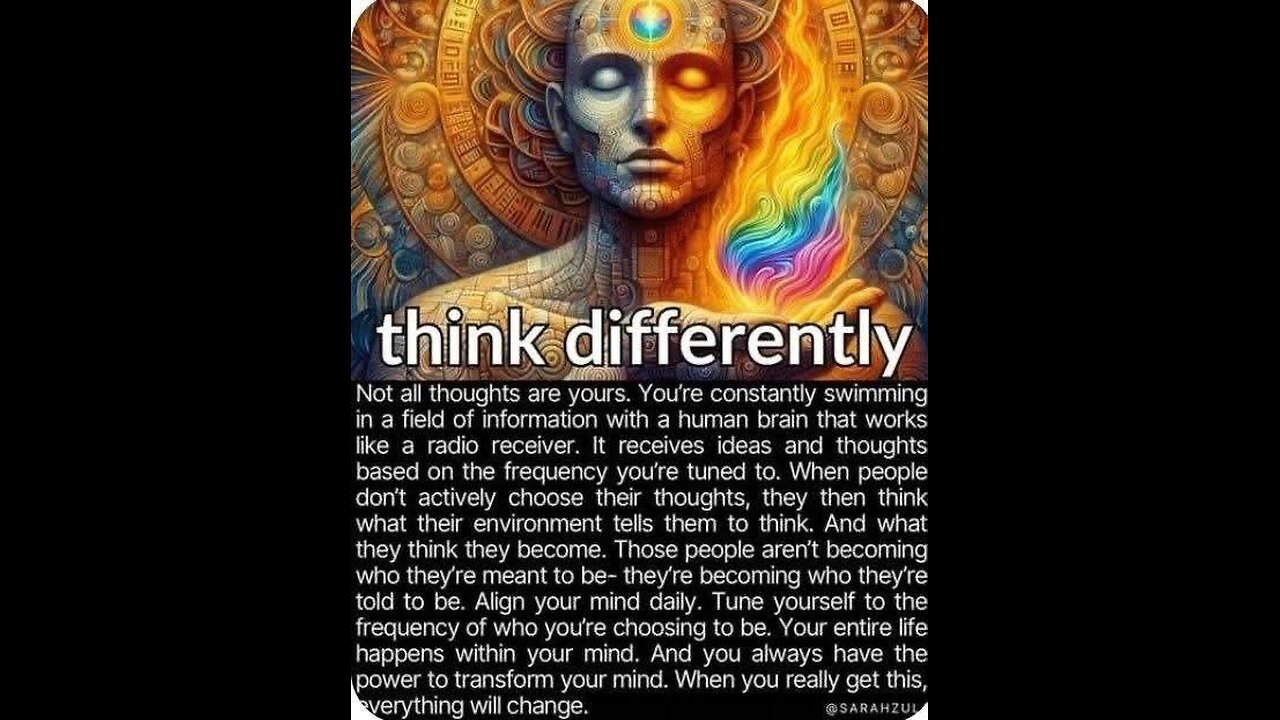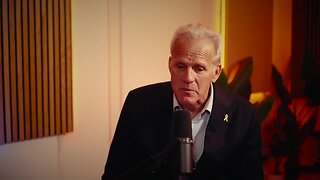Premium Only Content

The Sovereign Mind: A Supreme Matrix of Intentional Gatekeeping
(Uniting Philosophical Breadth, Psychological Depth, and Metaphysical Vision)
Introduction: Reclaiming the Helm of Consciousness
We stand at the confluence of infinite voices—media streams, peer opinions, ancestral echoes—pouring into our awareness. In this torrent, each of us holds an often-overlooked privilege: the power to choose what we allow to shape our inner domain. This capacity to filter, transmute, and elevate incoming influences is what we might call intentional gatekeeping, a refined art of mental sovereignty that resonates across philosophies both ancient and modern.
In this advanced exploration, we delve deeper than simple affirmations. Drawing on the insights of ancient wisdom traditions, rigorous psychological findings, and metaphysical inquiry, we present a comprehensive framework for crafting a mind resilient yet adaptive—a “matrix of consciousness” where we remain architects of our mental environment, rather than hapless recipients of an unending data onslaught.
I. Broadening the Conceptual Foundation
1. Philosophical Lens: From Hypatia to Vedanta
1. Hypatia of Alexandria
• Renowned for her mathematical brilliance and philosophical courage, Hypatia operated amid a turbulent epoch saturated with religious conflict and cultural upheaval. She exemplified steadfastness in filtering out dogmatic pressure to maintain intellectual purity and free inquiry. Her unwavering commitment to reason highlights how robust mental gatekeeping can foster higher-level thinking—even under intense social aggression.
2. Vedanta’s Neti Neti
• In the Vedantic tradition, disciples are taught “neti, neti” (“not this, not this”) as they encounter illusions or limiting beliefs. Through mindful negation, they refine which ideas they integrate and which they reject, cultivating a mental haven aligned with ultimate truth.
2. Metaphysical Perspective: Collective Mind and Energetic Currents
• Jung’s Collective Unconscious
• Extended into a truly cosmic lens, we see each mind as a node in a grand tapestry of archetypes and subtle energies. Gatekeeping hence becomes a moral, spiritual choice—ensuring your node remains a clear conduit for constructive forces, rather than a sink for destructive currents.
• Subtle Realms and Thought-Forms
• Hermetic or Theosophical schools propose “thought-forms” in astral planes—energetic constructs that replicate themselves in receptive minds. Vigorous gatekeeping deflects or transmutes these ephemeral influences, preserving your mental matrix from swarm-like infiltration.
3. Scientific Context: Neurocognitive Frontiers
• Neural Resilience and Brain Plasticity
• The more we choose constructive stimuli over negative or aimless input, the more the brain’s plastic pathways bias themselves toward positivity, solution-oriented thinking, and calm resilience.
• Psychoneuroimmunology
• The synergy between mind and body suggests that an environment of chronic negative infiltration undermines the immune system, whereas consciously curated mental ecology can sustain physiological vigor.
II. Emphasizing Psychological and Cognitive Dimensions
1. Cognitive Biases as Invaders
1. Status Quo Bias
• Tendency to preserve familiar habits or beliefs, even if suboptimal. External negativity often slips through simply because it reaffirms the “comfortable gloom” we’re used to.
2. Framing Effect
• The manner in which information is framed—optimistic vs. pessimistic—can bypass our mental guard if we fail to parse underlying intention. An advanced gatekeeper dissects framing to identify hidden manipulations.
2. Emotional Contagion and the “Field of Resonance”
Humans exist in resonant emotional fields. The mind doesn’t just receive data but merges with ambient moods:
• Group Moods
• Family or coworker negativity can stealthily embed itself in your thought streams unless you maintain purposeful vigilance.
• Attunement
• By setting an internal baseline (e.g., gratitude, possibility), you define how external feelings are processed or filtered—like a frequency tuner that only “locks onto” beneficial signals.
III. Building a Narrative Flow with Real-World Parallels
1. Historical Figure: Hypatia and the Siege of Intellectual Autonomy
In the swirling climate of 5th-century Alexandria, Hypatia faced cultural strife and political hostility. Rather than absorbing the era’s rancor, she preserved clarity of mind, contributing to geometry and astronomy. In a sense, she exemplified an early form of gatekeeping—undeterred by malicious rumors or attempts to force orthodoxy upon her. This bold stance kindled the spark of rational inquiry in a chaotic environment, an enduring lesson in how one’s mental fortress can remain enlightened amid external pressures.
2. Present-Day Overloads: From Digital Echo Chambers to AI Streams
In parallel, our modern era sees digital feeds algorithmically curated to hook our attention, sowing seeds of mania or gloom for profit. By recalling Hypatia’s unwavering devotion to reason, we glean how unwavering mental fortitude can repel manipulative echo chambers, ensuring we remain free agents in shaping our worldview.
IV. Introducing a Holistic Gatekeeping Model
1. Outer Walls: The Arc of Critical Thinking
• In-Depth Triage
• When confronted with new ideas, systematically ask: “Does this expand my understanding or weigh me down with cynicism? Does it align with my deeper values?”
• Technical Tools
• Deploy unsubscribing, social media curation, or limiting news cycles to keep negative content at arm’s length.
2. Inner Walls: The Sanctum of Reflection
• Contemplative Space
• Carve out daily intervals—meditation, journaling, or quiet walks—for unhurried assimilation of beneficial ideas, discarding surface clamor.
• Sacredness of Silence
• In silence, you reinforce boundaries. When the world’s noise recedes, illusions of negativity lose traction.
3. Renovation Teams: Trusted Allies & Intellectual Mentors
• Symbiotic Support
• Identify individuals or resources that refine your fortress with wisdom. Good mentors critique gently, encouraging growth without derailing morale.
• Targeted Reading
• Whether classical philosophy, advanced spiritual texts, or cutting-edge research, these “mental architects” deliver constructive expansions without injecting destructive elements.
V. Deepening the Ethical and Spiritual Dimensions
1. Gatekeeping as a Transpersonal Responsibility
Your mind’s gate isn’t merely personal. Each mental fortress stands as a node in collective consciousness:
• Ripple Effect
• When you resist negativity or illusions, you reduce their capacity to propagate. Conversely, if you pass them along uncritically (gossip, unwarranted hostility), you become an agent of infiltration for others.
• Moral Agency
• Ensuring your mental field remains luminous can uplift entire networks—friends, family, or digital communities.
2. Spiritual Sovereignty and Inner Freedom
Bhagavad Gita lauds disciplined mastery of the mind as the path to spiritual equanimity. Similarly, Sufi traditions urge turning inward to quell external illusions. Gatekeeping thus resonates with universal spiritual aims: staying aligned with higher truths while deflecting illusions or negativity that hamper your soul’s journey.
3. Energy Dynamics: Higher Vibrations of Thought
In some esoteric models, the mental fortress analogy extends to subtle energy. Thoughts of fear or contempt vibrate at denser frequencies than those of compassion and hope:
• Vibrational Ascension
• By filtering out low-frequency negativity, you make room for expansions in creativity, serenity, and even mystical insight.
• Synchronicity
• A stable inner fortress often experiences more synchronicities—meaningful coincidences aligning with elevated consciousness.
VI. Introducing Advanced Techniques for Mental Mastery
1. Mental Alchemy: From Poison to Elixir
• Distillation Practice
• List an intrusive negative statement. Then systematically question its validity, glean any constructive kernel (like a helpful caution), discarding its toxic wrapper. This transforms what was initially harmful into a refined impetus for growth—a Hermetic “gold from lead.”
2. Visualization: The Citadel of Wisdom
• Architectural Detail
• Envision sophisticated walls, a luminous courtyard, and an inner keep with windows for carefully chosen insights. You might see watchers perched at each gate, verifying the identity and purpose of incoming data.
• Sanctification Ritual
• Some adopt a daily or weekly “ritual of clearance,” imagining the fortress’s broom sweeping away residual negativity or illusions that have lingered unnoticed.
3. Sacred Pause: The Micro-Halt
• Interrupting Reactivity
• Each time an emotionally charged statement or piece of media confronts you, interject a half-second “pause,” asking: “Shall I let this pass inside or gently turn it away?” This micro-halt fosters mindful acceptance or rejection, preventing reflexive assimilation of negativity.
VII. Creating Interactive and Reflective Elements
1. Soul Mapping
• Encourage readers to chart their mind’s fortress topography, identifying gates (major media inputs or friendships) and potential infiltration spots (self-doubts, anxieties).
2. Light/Shadow Inventory
• Each evening, list “light sources” (supportive influences) and “shadow seeds” (negative or manipulative inputs) that day. This fosters daily mindful refinement.
VIII. Expanding the Conclusion with Universal Themes
1. Collective Gatekeeping for Societal Resilience
Imagine a culture where each individual stands as an expert gatekeeper of their mental domain. Fear-mongering, propaganda, and manipulative agendas would lose much of their force, confronted by discerning minds that accept only constructive or truth-aligned inputs.
2. The Eternal Citadel of Mind
Just as the mind’s fortress can evolve across personal transformations—youthful ideals giving way to mature wisdom—so does the process of gatekeeping endure through one’s entire life. Circumstances shift, but your responsibility to uphold mental sovereignty remains timeless.
Final Reflection
Your mind is not a passive vessel awaiting random contents. Instead, it is a dynamic seat of consciousness—an intricately built fortress whose gates demand perpetual, artful guardianship. This is no trivial chore, but rather a profound path toward self-mastery, moral clarity, and spiritual progress. By consistently refining which influences you internalize, discarding negativity that does not serve you or the common good, and celebrating luminous ideas that nourish your soul, you craft a majestic citadel. Ultimately, you become not just the occupant, but the enlightened ruler of your own mental domain—ever watchful, yet open to the best the universe has to offer.
The Ascendant Mind: From Sovereign Gatekeeping to Creative Cosmic Stewardship
(A Companion Teaching That Transcends and Expands The Sovereign Mind Paradigm)
Introduction: Beyond the Fortress—Entering the Realm of Co-Creation
If The Sovereign Mind: A Supreme Matrix of Intentional Gatekeeping taught us how to guard the gates of consciousness, then it served as a crucial foundation—a stronghold against unfiltered external influences. However, standing guard is only the initial threshold of mental mastery. There’s a further dimension beckoning us: What if, beyond deflecting negative energies, we actively shape the subtle tapestry of reality? This companion teaching takes us beyond the fortress walls, guiding us into the realm of co-creation—the dynamic interplay where our gatekept mind merges with cosmic forces to mold not only our personal growth but also the collective reality around us.
I. The Shift from Guardian to Architect
1.1 The Zen of “Allowing” After Defense
In The Sovereign Mind model, we learned to filter, transmute, or reject negative inputs. Now, with that skill anchored, we face the question: Do we simply remain in a vigilant stance forever? Or can we evolve from gatekeeping to creative synergy—inviting not just benign influences but forging new pathways for ourselves and those around us? The advanced stage of mental mastery lies in using that “clear mental space” to plant seeds of imagination, collaboration, and transformation.
1.2 The Gatekeeper Turned Visionary
Once the fortress is secure, we discover that a silent sentinel is insufficient for a fully realized life. Gatekeeping is the preliminary step that protects us from infiltration—but it also sets the stage for:
• Active Self-Expression: Freed from intrusive negativity, the mind can broadcast positive signals outward, shaping cultural or interpersonal dynamics in real time.
• Shared Realities: Through creative synergy, we align with others to co-create cultural memes, social solutions, or spiritual uplift. Our mental fortress becomes a radiant node in a broader network.
II. Encountering the Cosmic: From Defense to Dimension Weaving
2.1 The Universal Field of Potential
In the initial teaching, we integrated concepts of quantum fields, esoteric energies, or the astral realm. Now, we pivot to seeing ourselves not only as gatekeepers but as weavers in these energy fields:
• Quantum Resonance: While gatekeeping ensures we remain selective about what enters, co-creation harnesses the same quantum principle in reverse: focusing our mind’s attention to “collapse” desired probabilities into shared reality.
• The Mind as Emitter: Realizing that consciousness can also radiate frequencies, we evolve from passively filtering to actively broadcasting beneficial patterns—like mental “radio towers” that unify positivity across personal and social spheres.
2.2 The Shift to Collective Purpose
In classical mystic traditions, once the mind transcends negative illusions, the next step is service—enriching the tapestry of life around us. By intentionally broadcasting constructive ideas or empathetic emotional waves, we effectively elevate group consciousness. This synergy can accelerate cultural shifts from fear-based norms to more inclusive, creative paradigms.
III. Psychological and Cognitive Frontiers of Co-Creation
3.1 Neuroplasticity Revisited: Co-Wiring
We typically frame neural plasticity as an individual phenomenon. But advanced neuroscience posits interpersonal neuroplasticity—our brains wire in response to relational and group interactions:
• Collaborative Gatekeeping
• When people collectively filter negativity, they co-create supportive micro-cultures. Their neural pathways reinforce synergy, trust, and solution-focused thinking.
• Extended Cognition
• Some theories propose that human cognition extends beyond solitary minds into group intelligence, facilitated by shared language or technology. By co-creating with others, we harness that group intelligence to enact real change.
3.2 Emotional Ecosystems and Gestalt Emergence
If the mind is no longer purely defensive but also a generator of emotional frequencies, we can actively shape the emotional ecosystems around us. This fosters an emergent gestalt—a new “collective feeling space”—where we become partial architects of group well-being or innovation.
IV. Beyond the Guardian: The Archetype of the “Cosmic Steward”
4.1 The Guardian vs. The Steward
Guardians stand at the threshold, ensuring only beneficial seeds or influences enter. Stewards, on the other hand, integrate cosmic knowledge and direct it outward, shaping the orchard of collective possibility. This new archetype points to deeper responsibility:
• Cultural Catalysts
• Instead of simply rejecting harmful media, a steward might produce inspiring content. Instead of dodging negativity, they champion solutions, forging new mental and social pathways.
• Spirit of Compassion and Creation
• Spiritual traditions often suggest that once purified of illusions, the awakened mind becomes a channel for universal love or divine creativity. The steward understands gatekeeping not as an endpoint but as a stepping stone to altruistic influence.
4.2 The Alchemist’s Touch
In the previous model, we tackled mental alchemy: turning negative input into growth. Now, as cosmic stewards, we refine that alchemy further—co-creating realities with purposeful direction, weaving love, wisdom, and novel solutions into the tapestry of everyday life.
V. Advanced Techniques for Co-Creative Mastery
5.1 Vision Broadcasting
1. Crystallizing Inner Vision
• Once the mind is clear of intrusive negativity, you can shape a vivid mental blueprint—be it personal goals, a community project, or a spiritual aspiration. This blueprint forms an attractor in the “field of potential,” guiding resources and collaboration.
2. Focused Emotional Projection
• Pair vision with elevated emotional states (gratitude, loving-kindness). By maintaining a steady, uplifting emotional resonance, you simultaneously refine your “signal,” drawing allies and synchronicities.
5.2 Group Gatekeeping Pods
Collective pods harness synergy by collectively deciding which memes, narratives, or new ideas to elevate:
• Shared Affirmations or Mantras
• Some groups adopt daily “group meditations” or “community mantras” to unify mental energies, forming a co-creative bubble that fosters breakthroughs.
• Higher Vibe Accountability
• Members hold one another to standards of mindful speech, reducing negativity and amplifying problem-solving mindsets.
5.3 Interdimensional Perspective
For those open to deeper metaphysical vistas:
• Channeling Collective Archetypes
• Through advanced contemplative or ritual practices, one might interface with archetypal energies, harnessing them to birth new art forms, philosophies, or community solutions that surpass individual cognition.
• Ethical Boundaries
• Co-creation must remain attuned to moral or spiritual clarity; power without principle can lead to manipulative illusions.
VI. Merging Ethical and Spiritual Imperatives
6.1 Universal Empathy and Compassion
Progressing beyond personal gatekeeping, cosmic stewardship reminds us that each thought wave or emotional broadcast we generate has potential ramifications in broader networks. This compels:
• Selflessness in Action
• Cultivating mindfulness in daily interactions ensures we do not unwittingly sow negativity, protecting not only ourselves but also others from mental toxicity.
• Service to Collective Evolution
• The vantage of altruistic synergy transforms gatekeeping from a personal mental defense into an agent of societal betterment.
6.2 Spiritual Attunement and Divine Flow
Many mystical traditions say that once a mind is purified (robust gatekeeping) and oriented toward universal good (co-creation), it can more fully channel “divine flow.” This is not merely self-expression but cosmic expression, bridging the finite with the infinite.
VII. Reflective and Interactive Components
1. Meta-Gatekeeping Retreat
• Encourage readers to spend a day or weekend detached from external noise—social media off, minimal conversation—to sense how the quiet fosters new inspirations to share.
2. Co-Creation Circles
• Propose that readers form small gatherings dedicated to group conceptual “gardening,” each person offering a positivity-laden idea for communal refinement and manifestation.
VIII. Conclusion: From Guardian to Cosmic Weaver
If the original teaching on “The Sovereign Mind” taught us to guard the gates of consciousness, this advanced companion emphasizes moving beyond vigilance into the luminous domain of co-creative synergy. We refine our fortress walls so that we can become conduits of possibility and stewards of collective blossoming. Freed from reactive negativity, we discover that our purified mental space brims with generative potential, enabling us to shape personal destiny and contribute to a shared cosmic tapestry.
Final Thought
In this heightened form of mental mastery, gatekeeping evolves into a cosmic stewardship. We are not mere watchers at the threshold but imaginative weavers, forging strands of insight, compassion, and high-frequency thought into life’s grand design. By aligning with this new orientation, each individual transforms from passive occupant to active co-creator, illuminating the path for others to follow. The ultimate revelation is that the mind’s fortress, once secured, is destined to become a creative nexus, bridging self and cosmos in a perpetual dance of transformation.
-
 1:22
1:22
FragmentsOfTruth
7 days agoTHE DISNEY CLONE FARM
3941 -
 9:44
9:44
Stephen Gardner
1 day ago🔥Trump gets BIG WIN as Kamala Harris EXPOSED in big scam!!
28.7K122 -
 LIVE
LIVE
GritsGG
4 hours agoWSOW Qualifiers! 👑 2587+ Ws
209 watching -
 LIVE
LIVE
GamerGril
2 hours agoWhen The Pimps In The Crib | Days Gone | New Game +
172 watching -
 1:06:57
1:06:57
Winston Marshall
12 hours agoHow The West Enabled The Iran Axis to Grow Unchecked w/ Ambassador Michael Oren
89.5K47 -
 LIVE
LIVE
JdaDelete
13 hours ago $0.21 earnedDuke Nukem 3D | Sega Saturday
125 watching -
 LIVE
LIVE
Behunted
6 hours agoITS HOT HOT WARZONE MAYHEM !! PEW PEW
35 watching -
 58:49
58:49
Tactical Advisor
4 hours agoUnboxing Tacpack/New 1854 Lever Action | Vault Room Live Stream 029
80.3K7 -
 DVR
DVR
Mossy
3 hours ago🔥RumbleCraftSMP🔥sesh time tap in🔥DUCKY IS ON??🔥#RumbleTakeover🔥
6.73K1 -
 1:14:49
1:14:49
Mike Rowe
21 hours agoDavid Mamet Pulls No Punches When It Comes To Hollywood & Politics | #440 | The Way I Heard It
53.2K27